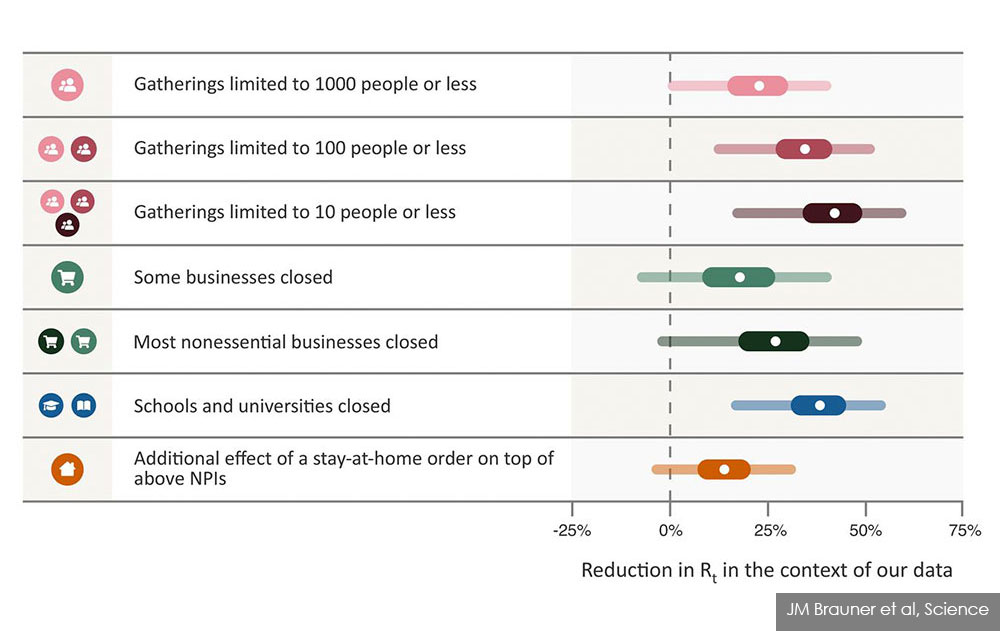COVID-19 | Early responses to the Covid-19 pandemic in many countries often included mandatory orders for its citizens to stay home, including the movement control order implemented in Malaysia beginning Mar 18.
However, a new analysis has revealed that such lockdowns only provided marginal benefit on top of other measures being introduced by various governments.
The paper published in the journal Science yesterday reported that banning gatherings of more than 10 people proved to be most effective, reducing Covid-19’s effective reproduction number (Rt) by 42 percent.
Closing both schools and universities meanwhile reduced Rt by 38 percent, and was the second most effective of the measures analysed in the study.
Shutting "high risk" face-to-face businesses such as restaurants, bars, nightclubs, cinemas, and gyms reduced Rt by 18 percent, while going further to close non-essential face-to-face businesses reduced Rt by 27 percent.
When all these measures are introduced, mandating that citizens must stay home except for work, shopping, and other specific purposes, it only reduced Rt by a further 13 percent.

The researchers did not model the effect of a stay-at-home order alone, as it is often introduced in conjunction with other measures that make its effects difficult to disentangle.
The effects of closing schools and universities were also not analysed separately for this reason and were thus lumped together in the study as a single measure.
Nevertheless, researchers noted that no single measure is sufficient in tackling Covid-19 and bringing the Rt to below one, which would indicate a declining outbreak. Instead, a combination of various measures would be needed.
“The estimated Rt likely could have been brought below one by closing schools and universities, high-risk businesses, and limiting gathering sizes to at most 10,” the authors wrote.
This combination reduced the Rt by 70.6 percent.
Assuming an R0 of 3.3 if nothing is done to prevent Covid-19 from spreading, the combination above reduced the Rt to 0.97.
For the record, both R0 and Rt are ways to describe a disease’s infectivity, with R0 assuming a population that has no prior immunity to the disease.
An R0 of 3.3 would mean that for every 100 infected people, another 330 would become infected in the next cycle of infection.
Reducing it to 0.97 would mean 97 people would be infected instead, meaning the size of the outbreak has become smaller than the initial 100 infected people.
According to the Health Ministry's website, Malaysia's Rt is estimated to be 1.06 as of Dec 14, indicating a growing outbreak where every 100 infected persons are infecting 106 more people.

Meanwhile, researchers have also developed an online calculator based on their findings to help guide policymakers.
The study was done by analysing the most common measures implemented by 41 countries this year up to the end of May, in an attempt to curb the spread of the coronavirus.
Most of these were European countries, but also included others such as Malaysia, Singapore, New Zealand, and Mexico.
The researchers noted the timing when each movement restriction was imposed or lifted by the government and the number of Covid-19 cases and deaths that followed.
However, they cautioned that their estimates should not be taken as the final word on the effectiveness of these measures, and advised “expert judgement” as they listed its caveats and limitations.
Among others, researchers said the Rt could have been reduced by other measures not considered in the study such as mask-wearing, and the effects of behavioural changes made voluntarily (i.e. not mandated by the government).
They added their findings cannot be used to predict the effect of lifting restrictions.
“For example, closing schools and universities in conjunction seem to have greatly reduced transmission, but this does not mean that re-opening them will necessarily cause infections to soar.
“Educational institutions can implement safety measures such as reduced class sizes as they reopen,” they wrote.
They also noted that their study was conducted from January up to the end of May, and circumstances may have since changed. - Mkini



No comments:
Post a Comment
Note: Only a member of this blog may post a comment.